The Philippine Statistics Authority (PSA), as stipulated under Republic Act 10625, is the agency tasked to promote and develop integrated social and economic statistics and coordinate plans for the integration of those statistics, including the national accounts. In response to this, the PSA, spearheaded by Macroeconomic Accounts Service (MAS) and in collaboration with the Regional Statistical Services Offices (RSSOs) and Provincial Statistical Offices (PSOs), has undertaken the pilot compilation of the Provincial Product Accounts (PPA). To date, a total of 46 provinces and 13 HUCs are compiling PPA. Siquijor is one of the first provinces who officially released the 2021 PPA through the conduct of data dissemination forum last 28 November 2022.
The economy of the province of Siquijor grew by 5.7 percent in 2021, a rebound from a contraction of -5.0 percent in 2020. This represents an increase in the value of the Gross Provincial Domestic Product (GPDP) of about 600 million pesos from 10.8 billion pesos in 2020 to 11.4 billion pesos in 2021. It can be noted that the province of Siquijor is one of the 16 provinces among the 46 pilot provinces that had surpassed the 2019 pre-pandemic level, with 2021 GPDP higher than the 2019 level by 0.5 percent. (Figure 1)
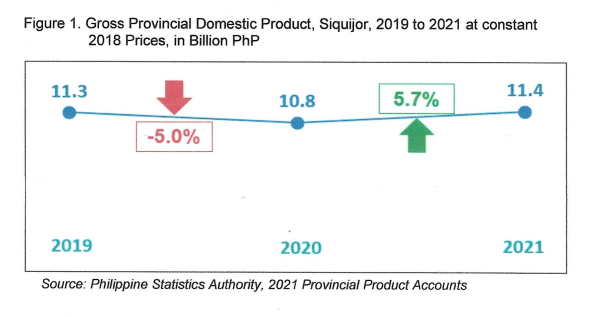
Of the 5.7 percent growth in 2021, Services contributed 5.0 percentage points, Industry had 0.9 percentage point contribution while Agriculture, forestry, and fishing, contributed -0.2 percentage point. (Figure 2)
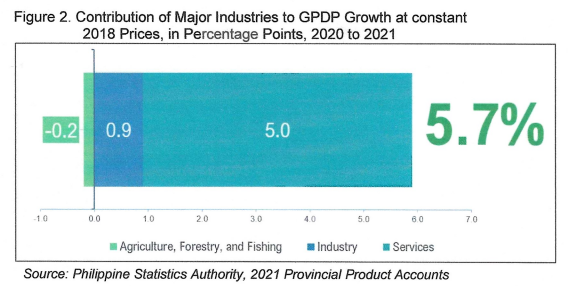
Among industries, the top contributors to the 5.7 percent growth were Wholesale and retail trade; repair of motor vehicles and motorcycles, with 1.6 percentage points (pp); followed by Public Administration and defense; compulsory social activities, with 1.5 pp; and Human health and social work activities with 0.6 pp.
Meanwhile, Accommodation and food service activities, and Agriculture, forestry and fishing contributed negatively to the GPDP growth of Siquijor. (Figure 3)
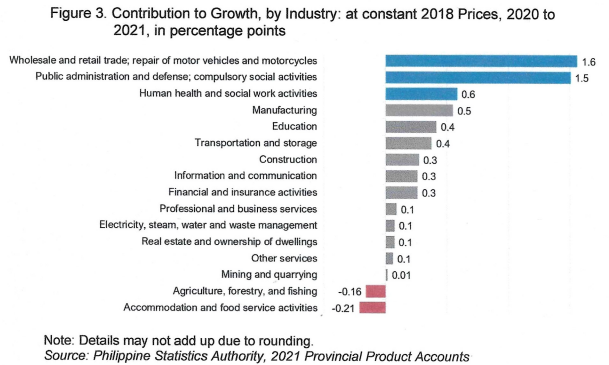
Services had the largest share of the economy of the province of Siquijor, with 71.1 percent, followed by Industry with a share of 14.5 percent, while Agriculture, forestry and fishing had a share of 14.4 percent. (Figure 4)
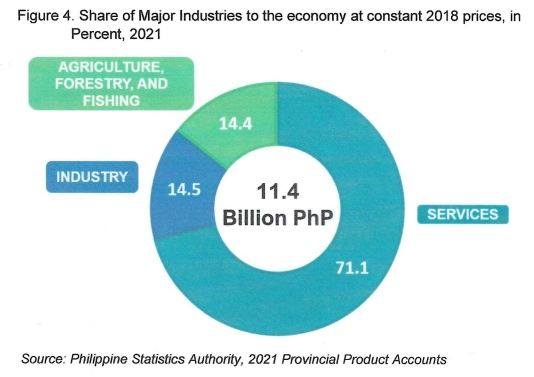
Wholesale and retail trade, repair of motor vehicles and motorcycles had the biggest share, with 39.4 percent. This was followed by public administration and defense, compulsory social activities with 13.1 percent share and Real estate and ownership of dwellings with 10.0 percent share. These three industries account for 62.5 percent share of the total services. The remaining 8 industries comprised 37.5 percent. (Figure 5)
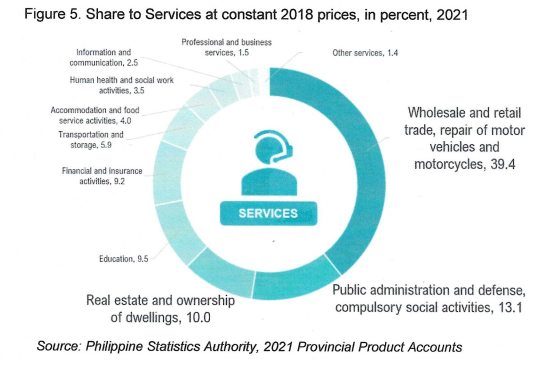
In Industry, Manufacturing and Construction had the biggest share of 42.6 percent, and 42.0 percent share, respectively; this was followed by electricity, steam, water and waste management with a share of 8.8 percent; and Mining and quarrying with 6.7 percent share. (Figure 6)
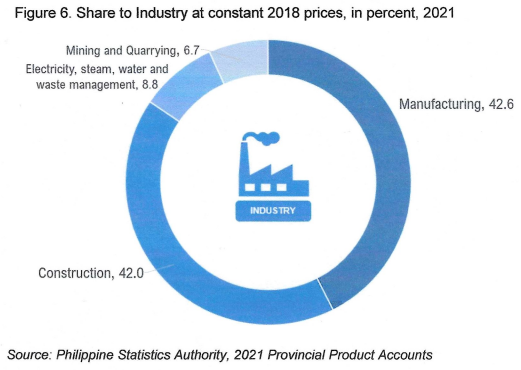
In terms of share to the GPDP of the province of Siquijor in 2021, the industries with the largest share were: Wholesale and retail trade; repair of motor vehicles and motorcycles, with 28.0 percent share; followed by Agriculture, forestry, and fishing, with 14.4 percent share; and public administration and defense; compulsory social activities with 9.3 percent share.
Per capita GPDP is the estimated average contribution of each individual to the total Gross Provincial Domestic Product. It is computed by dividing the GPDP by the total population of the province. The Per Capita GPDP of Siquijor was estimated at 112,470 pesos in 2021, or 4.9 percent higher compared with the 107,215 pesos in 2020. (Figure 7)
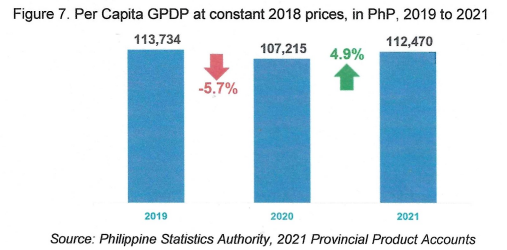
Economic performance of Siquijor Province vis-à-vis other economies in Central Visayas.
Among the four provinces and three HUCs of the Central Visayas region, the 5.7 percent growth of the GPDP of Siquijor was the third fastest. The City of Cebu and the City of Mandaue posted the fastest growths of 6.9 percent and 6.2 percent, respectively. Among the provinces in 2021, Siquijor was the only province that posted faster growth than the regional growth rate of 5.4 percent. (Figure 8)
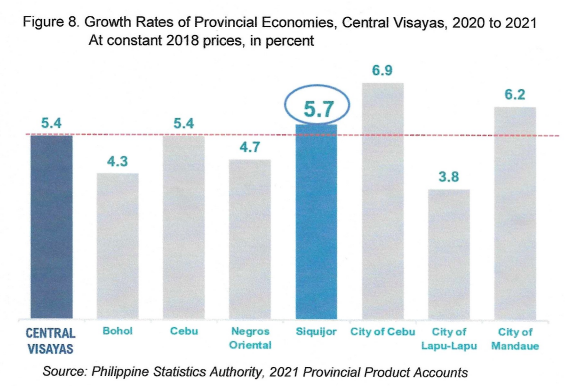
In terms of share to the total GRDP of Central Visayas Region in 2021, Siquijor had the smallest share of 1.0 percent. (Figure 9)

In Agriculture, Forestry and Fishing, the province of Siquijor shared 1.85 percent of the total AFF of Central Visayas in 2021. (Figure 10)
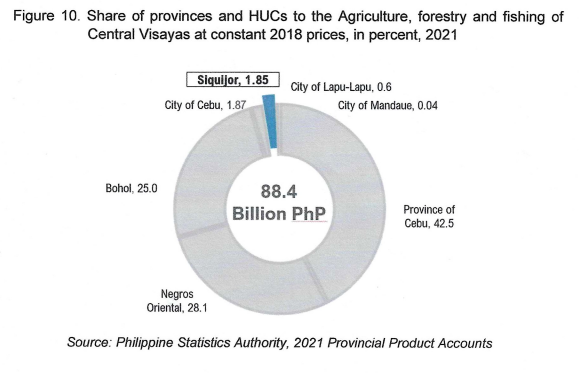
In Industry, the share of Siquijor was 0.6 percent. (Figure 11)
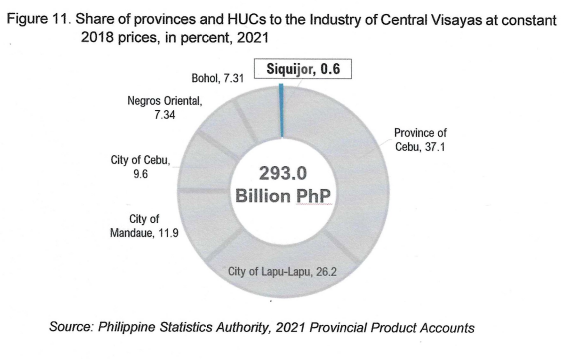
In Services, Siquijor shared 1.0 percent of the total Services of Central Visayas in 2021. (Figure 12)
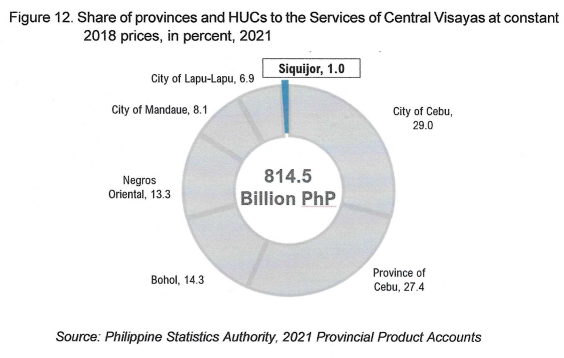
In terms of per capita, the province of Siquijor and the rest of the provinces posted per capita GPDP lower than the regional per capita GDP of 148,463 pesos. While the three HUCs, namely, the City of Lapu-Lapu, City of Cebu and City of Mandaue recorded per capita GDP higher than the regional per capita GDP. (Figure 13)
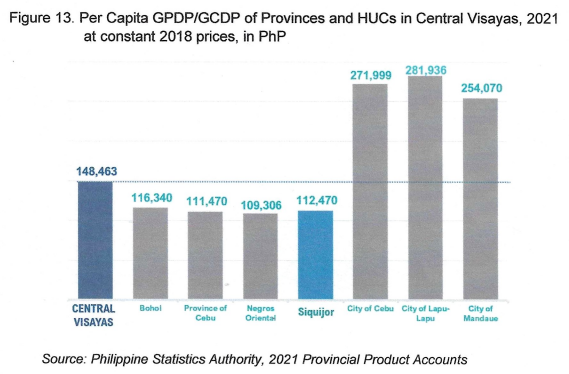
TECHNICAL NOTES
Provincial Product Accounts (PPA)
The Provincial Product Accounts (PPA) is a mechanism to compile the Gross Domestic Product using production approach at the subregional level.
Gross Domestic Product (GDP)
Gross Domestic Product or GDP is a comprehensive measure of economic activity. It measures the value of all final goods and services produced within the economy in a given period of time.
The provincial GDP is measured following the same framework as the internationally recognized System of National Accounts used in the regional and national compilation of GDP. Following the production approach, where:
GDP = Sum of Gross Value Added (GVA) of all industries.
GVA = Gross Output less Intermediate Consumption
Key considerations in the compilation of PPA
• PPA to adopt the production approach to derive GDP
• PPA to cover the 16 major industries
• Base Year 2018 will be adopted (aligned with the national and regional accounts of the Philippines)
• 2018 as benchmark year; to estimate succeeding recent years.
The Role of PSA in Economic Accounting
The Philippine Statistics Authority (PSA) which was established through Republic Act No. 10625 or the Philippine Statistical Act of 2013, is tasked, among others, to compile and maintain macroeconomic accounts and indicators, at the national and subnational level.
The PSA through the Macroeconomic Accounts Service regularly releases the quarterly and annual national accounts, annual regional accounts, and other economic accounts.
SGD. JOSELITO C. MAGHANOY
Supervising Statistical Specialist/OIC















